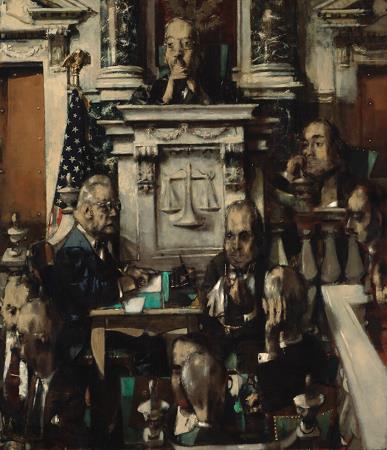Boston Expressionism Painting. Boston Expressionist paintings are characterized by their intense brushwork, bold colors, and distorted forms. The artists often explored themes of identity, alienation, and social injustice. Their work frequently featured distorted figures, symbolic imagery, and a sense of psychological depth. The movement's emphasis on emotional intensity and personal expression set it apart from other contemporary art movements. Boston Expressionism is an arts movement marked by emotional directness, dark humor, social and spiritual themes, and a tendency toward figuration strong enough that Boston Figurative Expressionism is sometimes used as an alternate term to distinguish it from abstract expressionism, with which it overlapped. Strongly influenced by German Expressionism and by the immigrant, and often Jewish, experience, the movement originated in Boston, Massachusetts, in the 1930s, continues in a third-wave form today, and flourished most markedly in the 1950s-70s. Most commonly associated with emotionality, and the bold color choices and expressive brushwork of painters central to the movement like Hyman Bloom, Jack Levine and Karl Zerbe, Boston Expressionism is also heavily associated with virtuoso technical skills and the revival of old master technique. The work of sculptor Harold Tovish, which spanned bronze, wood and synthetics is one example of the former, while the gold-and silverpoint found in some of Joyce Reopel's early work exemplifies the latter. Christmas Tree by Hyman Bloom, 1945 Hyman Bloom and Jack Levine Hyman Bloom and Jack Levine, both key figures in the movement, shared similar roots. Both grew up in immigrant communities: Bloom in the slums of Boston's West End and Levine in the South End. In the 1930s, having attended settlement house art classes as children, both won fine arts scholarships and trained at the Fogg Museum with Denman Ross. Both also drew on their Eastern European Jewish heritage, and were strongly influenced by the starkness and angst of German Expressionism and by then contemporary Jewish painters, such as Chagall and Soutine. Bloom tended to explore spiritual themes, while Levine was more inclined toward social commentary and dark humor, but both came to prominence in 1942 when they were included in Americans 1942: 18 Artists from 9 States, a Museum of Modern Art exhibition curated by Dorothy Miller. Soon afterward, Time magazine called Bloom one of the most striking of U.S. Colorists, and Levine won a prize at an exhibit in the Metropolitan Museum in New York. Together, they were referred to as the bad boys of Boston. Karl Zerbe Street Scene #2 by Jack Levine, 1938 Another influential artist at the time was Karl Zerbe, a painter from Germany who had studied in Italy and whose early work had been condemned by the Nazis as degenerate. Zerbe emigrated to the United States in 1934, settling in Boston where he headed the Department of Painting at the School of the Museum of Fine Arts. Zerbe helped reinvigorate the staid Boston art scene by bringing European ideas, particularly those of the German Expressionists, to Boston. He arranged for Max Beckmann and Oskar Kokoschka, among others, to lecture at the museum school.
more...












